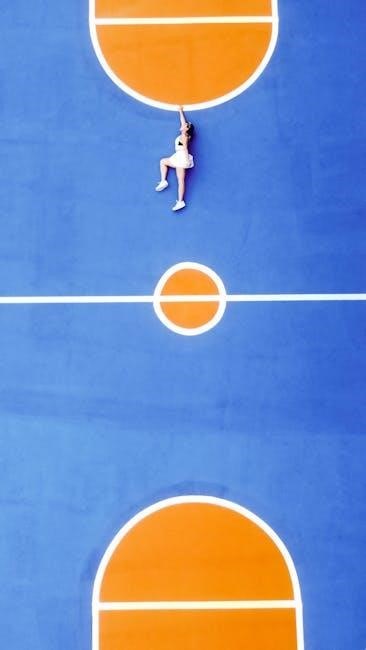basketball court diagram with labels pdf
Basketball court diagrams with labels provide a clear visual representation of court layouts, helping players, coaches, and fans understand key areas like the free throw line and three-point arc.
1.1 Overview of Basketball Court Layouts

A basketball court diagram with labels provides a detailed representation of the court’s structure, highlighting key areas such as the free throw line, three-point arc, and center circle. The court is divided into two halves, with hoops at each end. Professional NBA courts measure 94 feet by 50 feet, while college courts are slightly smaller. International courts, like those in FIBA, have their own dimensions. The free throw line is 15 feet from the hoop, and the three-point line varies by league. Labels are essential for identifying these features, ensuring clarity and understanding for players, coaches, and fans. The layout must be precise to reflect accurate measurements and markings.
1.2 Importance of Labeled Diagrams for Understanding Court Dimensions
Labeled basketball court diagrams are essential for understanding the precise measurements and features of the court. They provide clarity on key elements such as the free throw line, three-point arc, and center circle, ensuring accurate dimensions. These diagrams help players, coaches, and fans visualize the court layout, making it easier to grasp strategies and positioning. For facility planning, labeled diagrams are crucial for designing courts that meet professional standards, such as NBA (94×50 feet), NCAA (94×50 feet), or FIBA (28 meters) dimensions. Labels ensure consistency and accuracy, making these diagrams indispensable for training, coaching, and facility construction. They simplify the complexity of court measurements, fostering better understanding and application.

Key Components of a Basketball Court Diagram
A basketball court diagram includes essential elements like the free throw line, three-point arc, and court dimensions, ensuring clarity and accuracy for players and coaches.
2.1 Court Dimensions: Length and Width
Basketball court dimensions vary by level, with professional NBA courts measuring 94 feet (29 meters) in length and 50 feet (15 meters) in width. College courts under NCAA standards are slightly smaller, at 94 feet by 50 feet as well, ensuring consistency. International courts, governed by FIBA, are 28 meters long and 15 meters wide. These standardized measurements ensure uniformity across all levels, from professional leagues to high school and youth competitions. Accurate court dimensions are crucial for gameplay fairness and strategy development, making labeled diagrams essential for understanding the spatial layout. Proper sizing also ensures player safety and optimal performance, as it aligns with official regulations.
2.2 Markings and Lines: Free Throw Line, Three-Point Line, and More
Basketball courts feature distinct markings that define gameplay boundaries and key areas. The free throw line is 15 feet from the basket, while the three-point line varies by level: 23 feet, 9 inches in the NBA, 22 feet, 1.75 inches in college, and 6.75 meters internationally. Additional lines include the half-court line, dividing the court, and the lane, which is 16 feet wide in professional play. These markings are essential for understanding scoring zones, player positioning, and tactical strategies. Accurate diagrams with labels provide clarity, helping players and coaches visualize spacing and movement. Properly marked courts ensure fair play and adherence to official rules, making them indispensable for training and competition.
2.3 Zones: Key, Paint, and Three-Point Arc
The basketball court is divided into distinct zones that play crucial roles in gameplay. The key, also known as the free throw circle, is a semicircular area 15 feet from the basket. The paint refers to the rectangular area near the hoop, measuring 16 feet wide in professional leagues. The three-point arc outlines the perimeter for three-point shots, with distances varying by level: 23 feet, 9 inches in the NBA, 22 feet, 1.75 inches in college, and 6.75 meters internationally. These zones are vital for understanding scoring opportunities, defensive strategies, and player positioning. Accurate diagrams with labels help visualize these areas, enabling better tactical planning and gameplay execution. Each zone’s dimensions and markings ensure consistent rules application across all levels of play.
2.4 Labels: Identifying Features for Better Understanding
Labels on basketball court diagrams are essential for identifying key features, ensuring clarity and precision. They highlight elements like the free throw line, three-point line, sideline, and baseline, with measurements provided for accuracy. For instance, professional courts have a free throw line 15 feet from the basket, while the three-point line is 23 feet, 9 inches in the NBA. Labels also specify zones such as the paint area and key, helping players and coaches understand spatial dynamics. Clear labeling aids in strategic planning, player positioning, and rule enforcement. Whether for training, coaching, or facility design, labeled diagrams ensure everyone understands the court’s layout and dimensions. This attention to detail makes basketball court diagrams indispensable for effective gameplay and education.
Variations in Basketball Court Diagrams
Basketball court diagrams vary by level, with professional, college, and high school courts having different dimensions and markings, ensuring accurate representation for each standard.
3.1 Professional Courts: NBA and FIBA Standards
Professional basketball courts, such as those in the NBA and FIBA, feature standardized dimensions and markings. NBA courts measure 94 feet by 50 feet, while FIBA courts are slightly smaller at 28 meters by 15 meters. These diagrams include the three-point line, free throw line, and key areas, with precise labels for clarity. The NBA three-point line is 23 feet, 9 inches from the basket, while FIBA’s is 22 feet, 1.75 inches. These variations are crucial for players and coaches to understand, ensuring accurate strategy development and gameplay. The labeled diagrams help in visualizing court layouts effectively, making them essential tools for professionals and enthusiasts alike.
3.2 College Basketball Courts: NCAA Dimensions
College basketball courts under NCAA regulations have specific dimensions that differ slightly from professional leagues. For men’s games, the court measures 94 feet in length and 50 feet in width, while women’s courts are 84 feet by 50 feet. The three-point line in NCAA is 22 feet, 1.75 inches from the basket for both men and women. The free throw line is 15 feet from the backboard, and the key (or paint area) is 12 feet wide at the foul line, tapering to 16 feet at the baseline. These labeled diagrams are essential for understanding NCAA court layouts, helping players, coaches, and officials visualize strategies and training drills effectively. The consistency in markings ensures fair play and uniformity across college competitions.
3.3 High School and Youth Basketball Courts
High school and youth basketball courts are smaller than professional and college courts, with dimensions tailored to younger players. According to the National Federation of State High School Associations (NFHS), high school courts measure 84 feet in length and 50 feet in width. The three-point line is 19 feet, 9 inches from the basket, while the free throw line is 15 feet. Youth leagues often use even smaller courts, such as 74 feet by 42 feet, to accommodate younger athletes. These scaled-down dimensions promote skill development and fair play. Labeled diagrams of these courts help coaches, players, and officials understand the layout, ensuring consistency and proper training. The key, free throw line, and three-point arc are clearly marked, making the game accessible and engaging for all ages.

Uses of Basketball Court Diagrams
Basketball court diagrams are essential tools for coaching, strategy development, and player training. They aid in visualizing plays, understanding positioning, and designing facilities. Labeled diagrams also support educational purposes, helping beginners grasp court layouts and rules effectively.
4.1 Coaching and Strategy Development
Basketball court diagrams with labels are indispensable for coaches and strategists. They provide a visual framework to design plays, assign player positions, and analyze defensive setups. By clearly marking key areas like the three-point line and free-throw line, these diagrams help coaches explain tactics during training sessions. They also enable the visualization of court spacing and player movements, making it easier to develop effective game plans. Additionally, labeled diagrams are used to study opponents’ strategies, identify weaknesses, and prepare countermeasures. This tool is essential for creating a cohesive team strategy, ensuring everyone understands their roles and responsibilities on the court. Coaches rely on these diagrams to simplify complex ideas, making them a cornerstone of modern basketball strategy development.
4.2 Player Training and Positioning
Basketball court diagrams with labels are vital for player training and positioning. They provide a clear understanding of court markings, such as the free throw line, three-point arc, and key zones, helping players visualize their roles. Coaches use these diagrams to demonstrate defensive and offensive strategies, ensuring players know their assignments. Labeled diagrams also highlight areas for drills, like dribbling lanes or shooting spots, making practice sessions more structured. By studying these visuals, players can improve their spatial awareness and positioning, leading to better performance on the court. These tools are essential for developing teamwork and ensuring players understand their responsibilities within the game’s framework. They simplify complex strategies, making training more effective and focused.
4.3 Facility Planning and Court Design
Basketball court diagrams with labels are invaluable for facility planning and court design. They provide precise measurements and layouts, ensuring courts meet professional standards like NBA, NCAA, or FIBA regulations. Architects and designers use these diagrams to plan spacing, markings, and equipment placement accurately. Labeled diagrams help visualize court dimensions, such as the 94-foot length for NBA courts, and ensure proper positioning of features like the free throw line and three-point arc. They also aid in adapting designs for different levels of play, from professional to youth leagues. By referencing these diagrams, facility planners can ensure safety, functionality, and compliance with athletic regulations, making them essential tools for constructing or renovating basketball facilities.
4.4 Educational Purposes for Beginners
Basketball court diagrams with labels are essential for teaching the fundamentals of the game to newcomers. They provide a visual guide to understanding court layouts, key markings, and player positions. Beginners can learn the locations of the free throw line, three-point arc, and other essential features. These diagrams also help explain basic rules, such as where players can move and how scoring works. By studying labeled diagrams, new players can gain a clearer understanding of the game’s structure and strategies. Coaches and educators often use these tools to break down complex concepts into simple, digestible information. This visual learning aid is particularly effective for young players or those new to basketball, ensuring they grasp the basics quickly and effectively.

How to Create a Basketball Court Diagram
Designing a basketball court diagram involves precise measurements and accurate labeling. Use specialized software or graphic tools to ensure scale and detail are maintained.

5.1 Tools for Designing Court Diagrams
To create accurate basketball court diagrams, various tools can be utilized. Graphic design software like Adobe Illustrator or CorelDRAW is ideal for detailed, scalable designs. CAD programs offer precision for professional layouts. Online platforms such as Lucidchart or SmartDraw provide user-friendly interfaces for quick creation. For simpler diagrams, Microsoft PowerPoint or Google Slides can suffice. Additionally, specialized sports diagram software, like Hudl or Coach’s Eye, offers templates tailored for basketball courts. When designing, ensure measurements align with official standards (e.g., NBA, NCAA, or FIBA). Labels should be clear and placed appropriately to identify key features like the free throw line, three-point arc, and zones. Choosing the right tool depends on your design expertise and the level of detail required.
For basketball court diagrams, accurate labeling and precision are essential. Begin by ensuring all measurements align with official standards, such as NBA, NCAA, or FIBA specifications. Label each key feature clearly, including the free throw line, three-point arc, and zones like the paint or key. Use distinct colors or fonts to differentiate elements for better readability. Include a legend or key to explain symbols and abbreviations. Double-check the positioning of markings, such as the center circle and sidelines, to maintain proportional accuracy. Regularly refer to official resources or templates to verify details. Consistency in labeling ensures the diagram is both informative and easy to understand for players, coaches, and fans. Attention to detail enhances the diagram’s reliability and educational value. Official NBA, NCAA, and FIBA websites provide labeled basketball court diagrams in PDF format. Sports equipment suppliers and educational coaching websites also offer downloadable resources. Official resources from the NBA, NCAA, and FIBA are reliable sources for labeled basketball court diagrams. These organizations provide detailed PDF documents that outline court dimensions, markings, and zones according to their respective standards. The NBA and FIBA offer international court layouts, while the NCAA focuses on college-level specifications. These resources are essential for understanding the precise measurements and official rules governing basketball courts. Coaches, players, and facility planners often use these diagrams to ensure compliance with regulations. By visiting the official websites or accessing their publications, users can download high-quality, labeled diagrams tailored to professional, collegiate, or international basketball standards. These resources are indispensable for accurate court design and strategic planning. Sports equipment websites and suppliers often provide labeled basketball court diagrams as part of their resources for customers. Companies like Spalding, Wilson, and other leading manufacturers include detailed PDF diagrams to help users understand court layouts. These diagrams are particularly useful for professionals and DIY enthusiasts looking to install or repaint courts. They typically include measurements for professional, college, and high school courts, ensuring accuracy and compliance with official standards. Suppliers also cater to international specifications, offering FIBA-approved diagrams. These resources are invaluable for coaches, facility planners, and anyone needing precise court dimensions for installation or training purposes. They ensure that every marking, from the free throw line to the three-point arc, is accurately represented. Educational and coaching websites are excellent sources for basketball court diagrams with labels. These platforms, such as basketballforcoaches.com and coachingtoolbox.net, provide detailed PDF diagrams designed to help coaches and players understand court layouts. Many websites cater to coaches, offering diagrams that highlight strategic positions, player movements, and key areas like the free throw line and three-point arc. Additionally, these resources often include variations for professional, college, and high school courts, ensuring they meet the needs of diverse users. Coaches can use these diagrams to develop game strategies, while players can gain a better understanding of positioning and roles. These websites are invaluable for educational purposes, making complex court layouts accessible to everyone. They are often free to download, making them a go-to resource for basketball enthusiasts. Basketball court diagrams with labels are essential tools for understanding game strategies, court dimensions, and player positioning, benefiting coaches, players, and fans alike. Basketball court diagrams with labels are essential for understanding game strategies, court dimensions, and player positioning. These diagrams provide clear visuals of key areas like the free throw line, three-point arc, and zones such as the key and paint. Labels ensure accurate interpretation of court layouts, making them vital for training, coaching, and game planning. Variations exist across professional leagues (NBA, FIBA) and college or high school levels, with specific dimensions and markings. Consistent labeling helps maintain clarity, enabling players and coaches to visualize strategies effectively. These tools are indispensable for both beginners learning the game and experienced professionals refining their tactics. Accurate basketball court diagrams with labels are indispensable for understanding game strategies, court dimensions, and player positioning. They provide clarity on key elements like the free throw line, three-point arc, and zones such as the key and paint. Consistent labeling ensures that diagrams are accessible to both beginners and professionals, facilitating effective training and game planning. By offering precise visuals, these diagrams help coaches and players visualize strategies, making them essential tools for success in basketball. Their importance lies in their ability to bridge the gap between theoretical knowledge and practical application, ensuring everyone involved can maximize their performance on the court.5.2 Best Practices for Labeling and Accuracy
Where to Find Basketball Court Diagrams with Labels
6.1 Official NBA, NCAA, and FIBA Resources
6.2 Sports Equipment Websites and Suppliers
6.3 Educational and Coaching Websites
7.1 Summary of Key Points
7.2 Final Thoughts on the Importance of Accurate Diagrams


